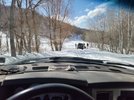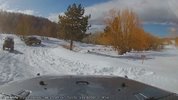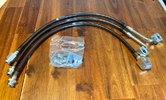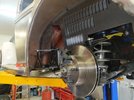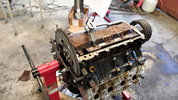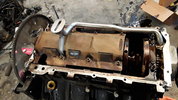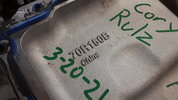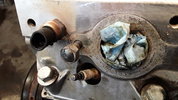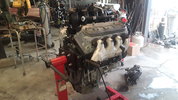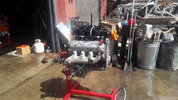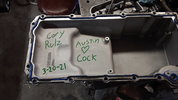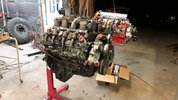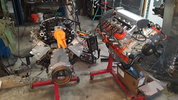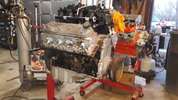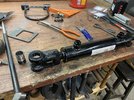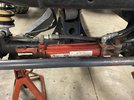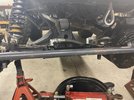It's been a long couple of weeks and I should have posted this as I've done it but here is a HUGE photo and description dump.
Sorry guys.
I've been working on installing a FASS (Fuel And Air Separation) system on our 2003 Monaco Dynasty on the Roadmaster S-Series chassis for the past couple of weeks. Unfortunately I've only been able to spend an hour here and there on it so it has drug out much longer than anticipated.
I purchased the FASS Titanium system back in October after returning from a gathering with our FMCA friends in Moab as one of them had just replaced their 2nd CAPS pump on their Cummins ISC. Seeing as the ISC and the ISL share the similar CAPS pumps I became a bit nervous/anxious and wanted to build myself in some additional reliability as my coach is racking up miles and I'm sure there is wear being introduced into the fuel system. The ISC and ISL engines are very reliable and great powerplants for mid to large sized diesel pusher RV's and the only area of concern is the CAPS system.
The CAPS pump system is the Cummins Accumulator Pump System that was a modular design. It was the design that Cummins used between the older mechanical fuel injection system used on the 8.3 prior to 1999 and before the HPCR (High Pressure Common Rail) fuel system that Cummins introduced around late 2003 for the 2004 model engines and is still being used today.
I have kept a very close eye on my fuel system over the years and have never had an issue with air intrusion like many fellow RV'ers but I have had to replace the OEM lift pump twice on our coach in the 14 years we've owned it. The OEM lift pump is not a continuous duty lift pump like found on the smaller Cummins B motors in light duty pickup trucks, rather the lift pumps on the ISC and ISL are merely to prime the system prior to starting. They run for a few seconds to build pressure to supply filtered fuel to the supply side of the injection pump. Once the engine fires, the lift pump shuts off and the injection pump pulls fuel using vacuum from the tank to the primary filter, then the lift pump, through the secondary filter and finally to the CAPS injection pump. As you can see this puts a big responsibility of the low pressure side of the CAPS pump to pull not only the 35+ feet from the tank but also through two filters. Add in wear over time that normally takes place and a gasket at the LPM (Lift Pump Manifold) where the lift pump mounts that is notorious for coming loose and leaking and there is a high probability that air can be introduced into the fuel system wreaking havoc on the CAPS injection pump.
I replaced my OEM lift pump when we first purchased the coach back in 2007 with 55k miles on it due to a slight leak that I detected. This was when ULSD was first being introduced as the CAPS system was not designed to run on ULSD and there was a surge of leaking Cummins lift pumps at the gasket as well as the electrical connectors. The lift pumps were the first to leak and create and air intrusion path to the fuel system, other areas such as connections soon followed to develop leaks. However, being under vacuum these leaks went undetected as they usually didn't leak fuel, they just sucked in air creating excessive wear and causing CAPS pump failures. I had replaced my OEM lift pump with an updated Cummins lift pump that was "redesigned" to cope with the ULSD fuel now being used. The coach ran perfectly until around 2014 when I had a stumble at higher RPM's and after extensive troubleshooting I discovered that the small check valve in the OEM lift pump was slightly stuck preventing flow of higher volume of fuel. I again replaced the lift pump with another OEM Cummins pump. The system has run flawlessly ever since and I keep a close eye on it knowing its possible shortcomings of having to draw fuel from such a distance.
After our friends 2nd CAPS failure and seeing a lot of failures popping up on RV forums I opted to build in a means of supplying constant fuel pressure to the CAPS pump as well as some additional filtering or "polishing" while I am at it. The FASS system seemed to be just what I was looking for. Fellow RV'ers have also used the AirDog system which is slightly different in the way it provides the fuel and I have also heard good things about them but ultimately any positive pressure you can give to the fuel on these CAPS engines is going to help immensely. It should also be worth noting that the engine's ECM is mounted to the side of the CAPS module system and utilizes the fuel to cool the ECM so an insufficient fuel flow can both starve the CAPS pump as well as affect the ECM. I have read failures of both over the last while.
As an FYI, most people seem to be mounting the FASS or AirDog pumps in the engine bays at the rear of these coaches in place of the primary filter. This makes for a very quick and easy installation as you simply remove the primary filter and insert the new fuel pump system in its place and wire it up. Many are still pulling through the OEM lift pump which seems to be working fine. I chose to go a different route and mount my FASS up front right next to the fuel tank behind the steer axle and tie into the existing fuel line feeding back to the engine. I have always been more fond of pushing fluids from the source rather than pulling from a distance but maybe that's just from my industrial maintenance background as those who are mounting their pumps in the rear engine bay are working fine without any issues.
I also chose to bypass my OEM lift pump and take it right out of the equation altogether. By doing so I did need to install a "dummy" relay to fool the ECM into thinking the OEM lift pump is still part of the system and avoid throwing any diagnostic trouble codes. The process I chose created a few hurdles but nothing that couldn't be overcome. Like most any mods or repairs on these large coaches, access is the biggest obstacle. Getting to the OEM lift pump to tap into the wiring and disconnect fuel lines took the most time. I also had to drop the starter motor for access which added some time but was well worth it terms of gaining access to perform a nice clean modification that looks as close to OE as possible.
Follow along as I try to document the installation of a FASS fuel pump into our 40' Monaco coach. Prior to beginning I wanted to get some jackstands under the coach and create a bit more space to crawl around.
Here is the system I went with. The FASS Titanium TS-D08-165G. Also some assorted NPT to JIC adapters & fittings.
Mounting the pump and filter assembly was the first item to address as space above the fuel tank was not adequate. The surge tank for our Aqua-Hot system also resided right behind the passenger steer tire in the fuel tank bay so after much deliberating I opted to relocate the Aqua-Hot surge tank and mount my FASS assembly in its place.
Aqua-Hot surge tank removed.
Area sanded with a DA and repainted with some extreme duty satin black paint.
Aqua-Hot surge tank relocated nearer to the Aqua-Hot unit after moving the primary and secondary water filters inboard about 2 inches. FYI, this is where the surge tank is mounted on the Executive and Signature models but their storage bags are slightly larger than on the Dynasty model.
Stay tuned for much more of the installation....


